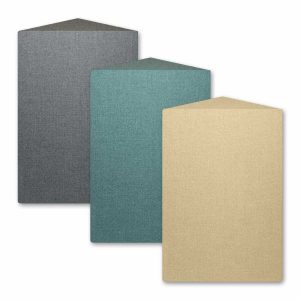Often I hear from customers looking to better control the sound in their studio or home theater. They know the sound, meaning the sound coming out of the speakers, is “perfect” or exactly how it should be, but it doesn’t have the same qualities when played in their studio or theater as when they listen with proper headphones. That’s because the room you’re in is a lot different acoustically than the headphone speaker sending the sound directly into your ears!
Many customers are familiar with acoustic panels, products placed on walls to help control the sound by reducing reverberation (echo). This is a fantastic way to improve the acoustics of any room. When it comes to the low end of the sound spectrum, commonly called the bass, an extra layer of treatment is required: a bass trap.
In this article, we’ll take a look at why the low end is unique, how it can negatively affect the total sound more readily than other parts of the spectrum, and how to use bass traps to wrangle a great bass sound.
Understanding Bass Frequencies
Everyone is familiar with low-end frequencies whether they realize it or not! Very generally speaking, the sounds we hear and enjoy are split between the low, middle, and high end of the frequency spectrum. The low-end, commonly referred to as the bass, is where all of the low sounds are heard. If you saw the films Jurassic Park and Jaws, those dinosaur roars in the former and the amazing theme song in the latter are great examples of the impact of bass frequencies. In those films, it was used on purpose to convey part of the storytelling. The low-end is noted for its power, and it is what anchors much of modern music, too!

Digital sound wave shapes.
Especially noted in rap, modern pop, and electronic music, the bass is the foundation the rest of the frequencies dance upon. Even beyond these genres, anytime there is a kick drum, that is the sound setting the stage (and the beat!) for the rest. Because it is so important, there is a whole industry devoted to the subwoofer, a type of speaker dedicated to reproducing and sometimes even boosting that low end for an improved experience.
The low-end is “powerful” exactly because of its specific frequencies. The “larger” sound waves can cause issues during playback in a room not acoustically treated to handle them. Because of the lower frequencies, bass sound waves are more likely to cause aural issues than other parts of the sound spectrum. “Muddy” and “boomy” are phrases often used to describe a poor low end during playback.
While acoustic panels handle the mid and high frequency range, there needs to be something to handle the bass and to control its sound. If you are experiencing muddy and boomy playback and want to clean it up so it sounds like it should, you need a bass trap!
What is a Bass Trap?
A bass trap works similar to the way acoustic panels work, but specifically for the low end. You can think of an analogy between speakers and a subwoofer:
- The speakers transmit middle and high frequencies and are sound controlled by acoustic panels.
- The subwoofer transmits low frequencies and is sound controlled with a bass trap.
Rooms where the bass sounds “boomy” or “muddy” is due to the corners of the room where walls meet walls and walls meet ceiling. The low frequencies reflect those frequencies and create what are called standing waves. Standing waves create the boomy, muddy low end sound that you didn’t hear while playing back through your headphones.
To solve this issue, the best course of action is to install a bass trap in the corners of the room to reduce the reverberation that causes standing waves. The low end will now come out as it should, and will not create a boomy environment nor negatively impact the middle and high ends.
Effective Bass Traps to Perfect Playback
Whether in your studio or in a home theater, a bass trap is the final piece after acoustic panels and a great sound system to achieve a wonderful playback. I advise my customers to look at our variety of bass traps to fit their specific needs:
AlphaSorb® Acoustic Foam Bass Trap — Natural foam in a choice of 2 colors with a flat or convoluted face.

AlphaSorb® Acoustic Foam Bass Trap – 4′ Convoluted in White Noise
AlphaSorb® Fabric Wrapped Acoustic Foam Bass Trap — Foam with a flat face covered in Guilford FR701 fabric facing, Guilford Anchorage fabric facing, or Sound Suede™ fabric facing and over 140 color choices.

AlphaSorb® Fabric Wrapped Corner Bass Trap
AlphaSorb® Fabric Wrapped Quick Ship Bass Trap — Fiberglass with a flat face and reverse mitered edges covered in Guilford FR701 fabric facing and 10 color choices. They include corner mounting hardware and are made-to-order, and can ship in a day or two for fast turnaround when you need it quickly.

AlphaSorb® Fabric Wrapped Quick Ship Bass Trap
No Matter Your Space, Work with Acoustical Solutions for Optimal Sound Control
I love to talk to customers about their specific situations and discuss the best ways for them to achieve the playback their sounds deserve. Especially in the home studio and home theater, creating the best environment possible for playback is such a rewarding project, and adding a bass trap could be the final piece towards perfection.
Please reach out to me today and we can discuss how to use bass traps, acoustic panels, and a variety of soundproofing solutions that will allow you to sit back and enjoy sound the way it was meant to be heard!
To learn more about how Acoustical Solutions can solve your noise control problems, use our contact form, call one of our Acoustical Sales Consultants at (800) 782-5742, or visit us on the web at acousticalsolutions.com.